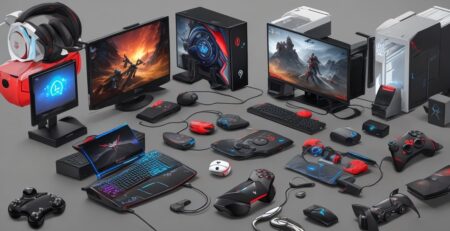How to Get the Best Performance Out of Your Gaming Setup
A lot has changed in the gaming setup since the days of cheap consoles and Windows PCs. Modern gamers demand high performance, immersive gaming, and fluid gameplay. Optimizing your gaming setup is essential to achieving these. This post will walk you through several optimization techniques, from software adjustments to hardware improvements, to maximize your gaming experience.
1. Recognising Your Needs for Gaming
1.1 Determining the Needs for the Game
Before optimizing, familiarise yourself with your games’ particular needs. The amount of resources required by modern games varies substantially. Look up the minimum and recommended specs for each Game to ensure your setup is appropriate for them.
1.2 Establishing Performance Objectives
Establish your goals for the gaming experience. Are you seeking virtual reality (VR) compatibility, high frame rates, or ultra settings? Setting priorities for the components of your setup that require optimization can help you define your goals.
2.Modernising Hardware Parts
2.1 Processor (CPU) Your gaming system’s CPU is its brain. For best results, select a high-performance processor with several cores and threads. Gamers frequently choose the AMD Ryzen and Intel Core series.
2.1.1 Excessive Replication
Increasing the CPU’s overclock can improve performance. To prevent system instability, stability testing and appropriate cooling methods are necessary.
2.2 A GPU, or graphics card
The GPU is essential for games to run smoothly and render graphics. For the best performance, spend your money on a high-end GPU from companies like AMD or NVIDIA.
2.2.1 Software and Drivers
Update the drivers for your GPU. Manufacturers often provide updates that address issues and enhance performance.
2.3 RAM, or memory
A sufficient amount of RAM is required to run current games smoothly and multitask. Try to have minimum RAM of sixteen gigabytes, ideally 32GB for programs that require greater processing power.
Memory Throughput
Speedier RAM can enhance functionality. Verify that your motherboard allows the RAM speed you have chosen.
2.4 Storage
Depending on your demands, choose between SSDs and HDDs. SSDs improve overall performance by providing speedier data access and load times.
NVMe and M.2 SSDs
M.2 and NVMe SSDs offer speeds that are even quicker than conventional SATA SSDs. We heartily endorse them for gaming configurations.
2.5 Cooling Remedies
Your components won’t overheat and experience performance throttling thanks to efficient cooling. Invest in high-quality liquid cooling systems, heatsinks, or fans to maintain ideal temperatures.
3. Improving Program Configuration
3.1 Changes to the Operating System
Boost gaming performance by adjusting your operating system settings. To achieve optimal performance, turn off superfluous background processes and adjust power settings.
Game Mode for Windows
To boost performance and prioritize gaming tasks, turn on Windows Game Mode.
3.2 Game Settings
Adapt the in-game settings to your system’s capability. Reduced resolution, texture quality, and shadow settings can significantly increase frame rates.
Refresh Rate and Resolution
To guarantee a fluid gaming experience, adjust your resolution and refresh rate settings to your monitor’s capabilities.
3.3 Software for Game Optimisation
Use programs like Razer Cortex or NVIDIA GeForce Experi to optimize game settings for best performance.
4. Improving the Performance of the Network
4.1 Wireless vs. Wired Networks
A wired Ethernet connection offers a more reliable and low-latency connection than
WiFi. A wired connection is strongly recommended for competitive gaming.
4.2 Network Hardware:
To prioritize gaming traffic, get a high-quality router with Quality of Service (QoS) capabilities. Think about a gaming router made with low latency performance in mind.
4.3 Internet Speed Make sure you have a low-latency, high-speed internet
connection. Check your internet speed frequently, and if required, think about increasing your package.
5. Configuration and Ergonomics
5.1 Gaming Chair: Invest in a cozy chair that promotes proper gaming posture.
Ergonomic chairs can make long gaming sessions more comfortable and fatigue-free.
5.2 Desk Configuration
Organize your workspace so that your mouse, keyboard, and monitor are at comfortable heights. An optimal gaming experience is enhanced, and strain is avoided with proper ergonomics.
5.3 Placement of the Monitor
Keep your monitor as close to eye level as possible to reduce strain. Look for a monitor with a high refresh rate and a short response time for optimal visual performance.
6. Consistent Upkeep and Modifications
6.1 Dusting and Cleaning
Keep your gaming setup clean regularly to avoid dust accumulation, which can reduce cooling effectiveness and performance. To maintain appropriate airflow and clean components, use compressed air.
6.2 Updates for Systems
Update your games, drivers, and operating systems to take advantage of bug fixes and performance boosts.
7. Final Thoughts
Upgrading your hardware, making software changes, and maintaining your system properly are all part of optimizing your gaming setup. You can attain optimal performance and a captivating gaming experience by comprehending your requirements, replacing necessary parts, and optimizing your setup. Maintaining your setup at the forefront of gaming performance may be achieved by regular maintenance and keeping up with the newest technological advancements.
If you adhere to my recommendations, you’ll have no trouble building a high-performance gaming setup that offers fluid, fun gameplay.










Leave a Reply